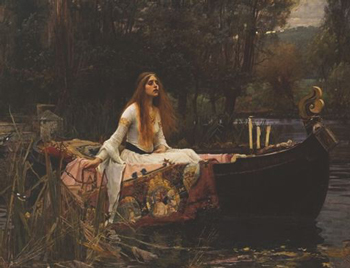
The Lady of Shalott

|
John William Waterhouse was born in 1849 in Rome. His father was a painter and it was with him that he first began to learn how to paint. He was assisting his father in his study when he was as young as nine years old.
Waterhouse painted classical, historical and literary subjects. He was particularly interested in tragic or powerful ‘femmes fatales’. Some good examples include his paintings of Ophelia, Miranda from The Tempest, Pandora, La Belle Dame Sans Merci and The Lady of Shalott. Both the Lady of Shalott and La Belle Dame Sans Merci are illustrations of lines of poetry. Lady of Shalott was based on a poem written by John Keats and La Belle Dame Sans Merci alludes to a poem written by Alfred Lord Tennyson.
Waterhouse painted several Lady’s of Shalott, each illustrating a different section of the poem. This particular painting illustrates the following lines:
‘And down the river’s dim expanse
Like some bold seer in a trance,
Seeing all his own mischance-
With a glassy countenance,
Did she look to Camelot
And at the closing of the day
She loosed the chain and down she lay;
The broad stream bore her far away,
The Lady of Shalott.
Waterhouse has captured the essence of these poetic lines in his paintings. The light in the painting makes us feel as if we are getting to the close of a long drawn-out, hot summer’s day. We see her glassy countenance as she looks to Camelot. One senses the Lady steeling herself for her act of departure. The painting evokes such an intense feeling of sympathy in the viewer that we feel almost as if we are in the boat with her and expect any second to feel the boat starting to carry us down the stream.












